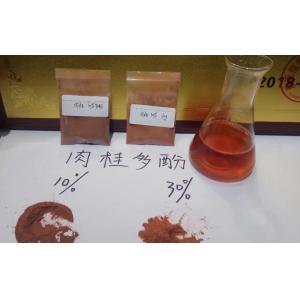
Add to Cart
Cinnamon Extract is one of PLAMED’s most important products. After lots of R&D work, we now have Cinnamon polyphenols, Cinnamon Proanthocyanidins, Cinnamon Flavonoids, Cinnamon Oleoresin and Cinnamon Essential Oil.
 |  |
| Cinnamon polyphenols | Cinnamon Essential oil |
 |  |
| Cinnamon Oleoresin | Cinnamon Flavor Powder |

Cinnamon plants have oval-lanceolate, rough-textured leaves approximately 7 to 20 cm in length. There are mainly two types of cinnamon, Cinnamomum verum, or C. zeylandicum or Ceylon cinnamon, which is considered the real cinnamon, and Cinnamomum cassia, or Chinese cinnamon. Harvesters usually cut the inner bark of the tree into the curled “sticks” which you can find in markets, and the bark can also be ground up into powder. With a sweet but pungent taste, cinnamon bark is one of the world’s favorite spices. What’s more, it has been used in traditional Chinese medicine to support proper digestion for more than 4,000 years.

| Cinnamon extract | Product name | Specification |
| Cinnamon Polyphenols | 10%, 20%, 30% UV | |
| Cinnamon Proanthocyanidins | 70% UV | |
| Cinnamon Flavonoids | 8%, 10%, 20% UV | |
| ANALYSIS | SPECIFICATION |
| Cinnamon Polyphenols content | 10%, 20%, 30% |
| Test Method | UV |
| Organoleptic | |
| Appearance | Fine Powder |
| Color | Yellow Brown |
| Odor | Characteristic |
| Taste | Characteristic |
| Part Used | Bark |
| Extraction Solvent | Ethanol & Water |
| Physical Characteristics | |
| Particle Size | 100% Through 80 mesh |
| Loss on drying | ≤5.00% |
| Ash Content | ≤5.00% |
| Heavy Metals | |
| Total Heavy Metals | ≤10PPM |
| As | ≤2PPM |
| Pb | ≤2PPM |
| Microbiological Tests | |
| Total Plate Count | ≤1000cfu/g |
| Total Yeast & Mold | ≤100cfu/g |
| E.Coli | Negative |
| Salmonella | Negative |
| Staphylococcus | Negative |

1. Lowering blood sugar
Cinnamon is frequently treated as an anti-diabetic compound, since it reduces the rate at which glucose enters the body. Cinnamon exerts its beneficial control effects in a number of ways.
Cinnamon can inhibit numerous digestive enzymes, such as alpha-glucosidase, sucrase and potentially pancreatic amylase. Via inhibition of these enzymes, cinnamon can decrease the absorption of glucose into systemic circulation and avoid overly significant insulin spikes.
In systemic circulation (beyond the liver) cinnamon also possesses anti-diabetic effects. A special group of compounds in cinnamon, Methyl Hydroxy Chalcone polymers (MHCPs), activate key enzymes that increase insulin sensitivity by stimulating their receptors, and inhibit the enzymes that deactivate their function.
2. Antioxidant
Cinnamon extracts appear to exhibit antioxidant action. In an experiment to determine the wound healing action of an ethanol extract of cinnamon, researchers suggested the significant increase in wound healing was attributable to the antioxidant activity demonstrated.